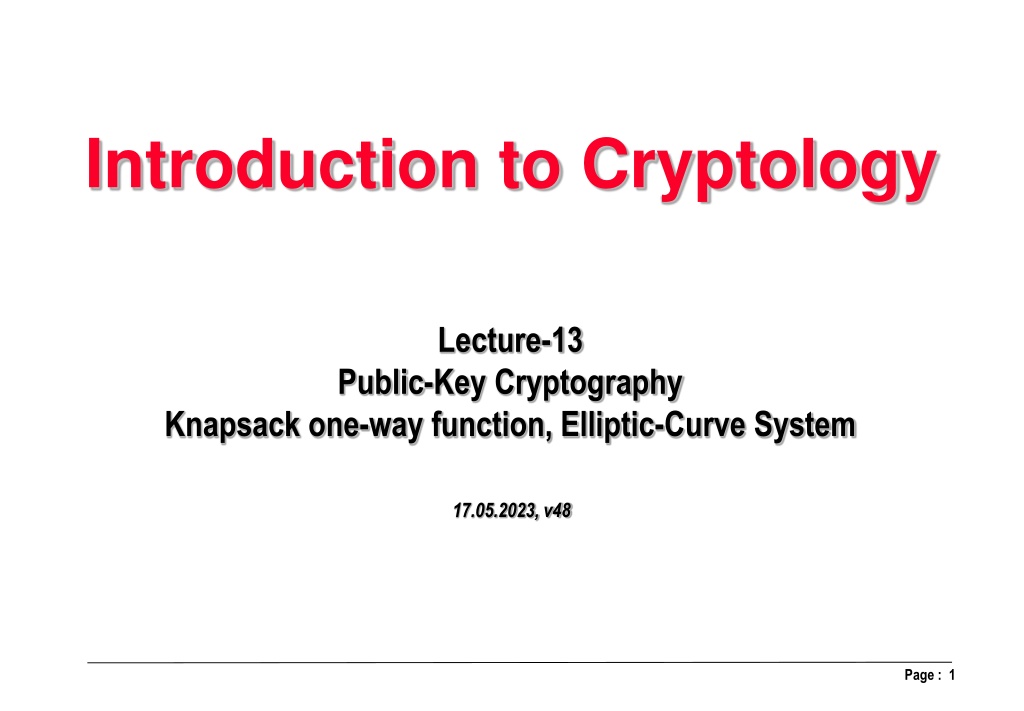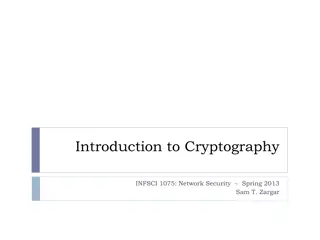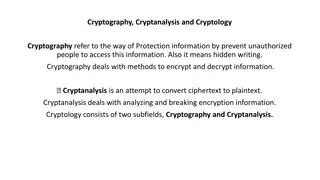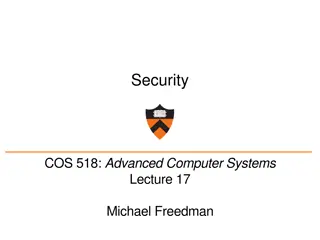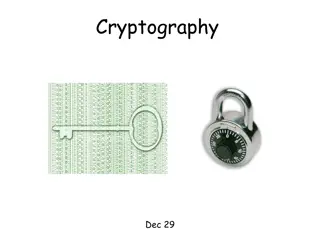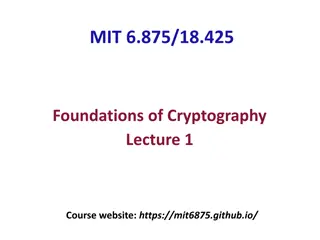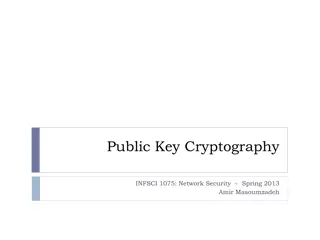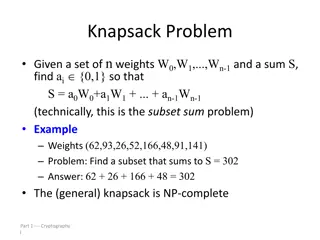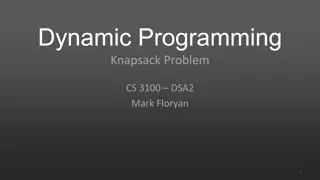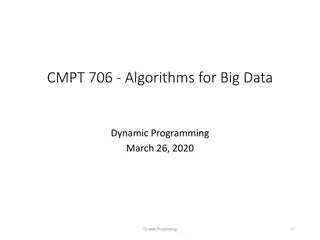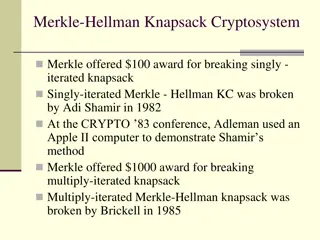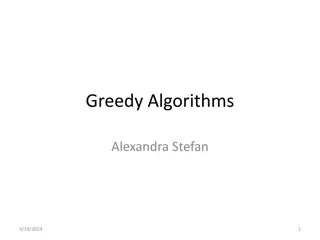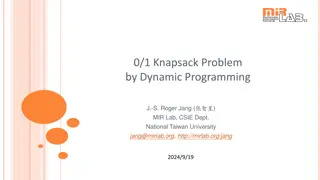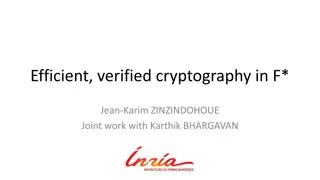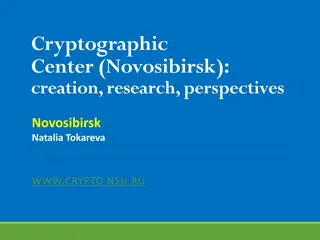Overview of Public-Key Cryptography and Knapsack Problem in Cryptology
This lecture delves into the realm of public-key cryptography, including the Knapsack one-way function and the Merkle-Hellman Crypto System. It explores historical perspectives, the concepts of OWFs, Elliptic Curve Cryptography, and introduces new algebra using additive groups over Elliptic Curves. The Knapsack Problem is elucidated as a one-way function, and the evolution of secure communication protocols is discussed through examples like the Diffie-Hellman system.
- Cryptology
- Public-key cryptography
- Knapsack problem
- Elliptic curves
- Merkle-Hellman
- Secure communication
Download Presentation

Please find below an Image/Link to download the presentation.
The content on the website is provided AS IS for your information and personal use only. It may not be sold, licensed, or shared on other websites without obtaining consent from the author. Download presentation by click this link. If you encounter any issues during the download, it is possible that the publisher has removed the file from their server.
E N D
Presentation Transcript
Introduction to Cryptology Lecture-13 Public-Key Cryptography Knapsack one-way function, Elliptic-Curve System 17.05.2023, v48 Page : 1
Outlines Historical Overview ! Knapsack One Way Function (OWF) Elliptic Curve Cryptography Summary of OWF s Page : 2
Knapsack Public-Key Crypto-System 1978 Ralph Merkle Berkeley Stanford University Published similar concept to Diffie-Hellmann system as a student at Berkeley University Secure communications over insecure channels Commun ACM, April 1978 (Berkeley Univ.), submitted Aug. 1975 Martin Hellman Stanford University Based on: Knapsack problem as a One-Way Function Page : 3
Knapsack Problem as a One-Way Function* Example: Given the following 6 items, each with its own weight: W1 W2 W3 W4 W5 W6 Example: Few items with a total weight of 449 g are in the bag. Question: Find which items are in the sack without opening it! Weight= 449 g n = i w ix Problem: Given the total weight of the knapsack = i 1 n = i Find the binary vector X = [x1, x2......], where xi= {0,1} Solution : X = [ 1 0 1 0 1 0 ] w ix Weight = i 1 - There is no algorithm known for finding X !!! (in the public literature - The solution is easy if the knapsack is superincreasing A Knapsack is a superincreasing one : if any Wi is greater than the sum of all other smaller weights. Example: the binary weight system 20, 21, 22 2n-1= 1, 2, 4, 8, 16 are used to represent an integer of n-bits * Ref. J. Massey Page : 4
Merkle-Hellmann Crypto System (1978)* (Broken by Shamir 1984) 1. Multiply each weight by u= 113 in Z199 2 5 8 17 35 71 select an easy knapsack 27 167 108 130 174 63 Convert to hard knapsack secret key is u = (m, u) = (199,113) Where gcd (199,113)=1 2. Permute locations and publish 174 27 167 63 108 130 published knapsack Public key Encrypt: X = [ 1 0 1 0 1 0 ] Y = 174 + 167 + 108 = 449 Cryptogram Plaintext 118 =113-1 in Z199 Decrypt : Y = u-1. Y = 118 . 449 mod 199 = 48 in Z199 from Y =48 find x = [0 1 1 0 1 0] in the easy knapsack permute to get the original message X = [ 1 0 1 0 1 0 ] Conditions : gcd ( u , m) = 1 and m Wi * source. J. Massey Page : 5
Summary: Widely Used Claimed One-Way Functions (OWF) /(Locks) are from Number Theory Summary of still claimed One-way Functions (OWF) we introduced so far Locking Un-Locking Discrete log Problem (DH Lock) a x Y a axmod p ? Y=ax x=loga Y Factorization Problem (RSA Lock) p q p q p.q m=p.q m ? X Factorization Problem (Rabin Lock) Y m Y=? mod m X2 mod m Y=X2 X m=p.q In addition to that: New Algebra using additive Groups over Elliptic Curves Page : 6
Elliptic Curve Based Crypto-systems Background: We introduced so far using the multiplicative cyclic group of the exponents of a primitive element for building a system in which the discrete logarithm is not computable was selected as a primitive element in GF(p) or GF(2m) having the maximum possible multiplicative order in GF. Thus { 1 2 3........ n=1 } is a cyclic group including all non-zero field elements. Claimed unsolved problem: If we know i, we do not know how to find i without exhaustive search (discrete logarithm problem). The basic arithmetic used was modular multiplication (or exponentiation modulo p or mod p(x)). Question: Are there other similar groups offering less complex arithmetic with similar cryptographic properties? The answer is yes with the following proposed algebra: An additive groups is defined by addition in in an elliptic curve system over GF(p) or GF(2m). was suggested independently by Neal Koblitz and Victor S. Miller n 1985. Page : 7
Elliptic Curve: Other Additive Group for Cryptosystems y F(x,y) = 0 y y P P Q x x -4P P -(P+Q) x -2P=-(P+P) 2P (P+Q) 4P -P Negation Adding P + P = 2P Adding P + Q An Additive Group of order n was found using a primitive point P having the large additive order n which can generate a large group. That is P + P + P ........+ P = n P = e where e is the neutral element of the group. n-times (n is very large) In this group it is still claimed that we do not know how to divide!. Example: if we know that Y = 5 P and we know P and Y, we do not know how to find 5 = Y/P. Cryptographic significance: If a secret key K is multiplied by a known element P to get Y=KP. If Y is publish with P, K is not possible to be found as it is not known how to compute K= Y/P . This is equivalent to the discreet logarithm computation problem. The used algebra is over GF(p) or GF(2m) Page : 8
EC- Examples in real fields 1/2 Page : 9
EC- Examples in real fields 2/2 Adding the points P and -P The line through P and -P is a vertical line which does not intersect the elliptic curve at a third point; thus the points P and -P cannot be added as previously to get the neutral point 0. Therefore, the elliptic curve group includes the neutral element point at infinity 0. By definition, P + (-P) = 0. As a result of this equation, P + 0 = P is in the elliptic curve group. 0 is called the additive identity of the elliptic curve group; all elliptic curves have an additive identity. Page : 10
Standardized Elliptic Curve Algebra over GF (IEEE 1363/D8) Used Koblitz Elliptic Curve equation (curves): Adding two point: P + Q = R yes no + = + + 2 3 2 P = Q ? y xy x a x b Addition in Elliptic Curve over GF (2n) (n should be prime for higher security) x, y are elements in GF(2n) A y1 B x1-1 A ( y2 + y1 ) B ( x2 + x1 )-1 Ext. gcd ! = x1 + A B = A B Adding two point: P + Q C 2 C 2 + = + + 2 3 2 y xy x a x b E is an Elliptic Curve (Koblitz) : with (IEEE 1363/D8, 10.1999) 0 b X3 C + + a X3 C + + ( x2 + x1 )+ a P = (x1,y1) and Q = (x2,y2) are two points on the curve. The sum is R= P Q , where R= (x3,y3) is computed according to the right flow chart E ( x1 + x3 ) F y1 + x3 If P = (x, y) then -P = (x, -y) R Y3 E + F X3 Page : 11
Multiplication in Elliptic Curve over GF (2n) How to multiply a point P by the scalar K. Computing Q = K . P Set Q P i := r 1 Double & Add technique 1. Convert K into the binary form: K = ( k rk r-1...... k 1k 0) with k r( MSB) = 1; i = i -1 2. Set : Q P Ki= 0 ? for i from r 1 down to 0 do a) Set: Q b) If k i= 1, then Set: Q 3. yes no If i=-1 Q + Q Q + P 4. Output Q. Set Q Q + Q Set Q Q + P Output Q Double & Add Multiplication Algorithm Page : 12
Why Elliptic Curve Cryptosystems ECC ? Key length and security motivations Claimed key length for RSA, DSA and ECC for similar security level ECC system is still claimed to exhibit higher security level for the same key length! Page : 13
Conventional Diffie-Hellman Public Key Distribution System Using Additive Groups over Elliptic Curves User A sends to B User B receives primitive element/ point on EC with order e ya= Xapublic key of A yb= Xbpublic key of B Xb= secret key of A Xb N (from 0 .. e-1) Xa= secret key of A Xa N (from 0 e-1) ya A, yb B, [ Xa] Xb [ Xb] Xa ZAB= XaXb ZAB= XaXb Shared Secret: ZAB Page : 14
El-Gamal Crypto-System Using Additive Groups over Elliptic Curves (EC) Algebra Over GF (2n) or GF(p) Neal Koblitz[1] and Victor S. Miller[2] in 1985 System mapping: Substitute addition instead of multiplication and multiplication instead of exponentiation! Same can be done for any discrete log based cryptosystem like Diffie-Helman tec. .. User A sends to B User B receives primitive element/ point on EC with order e ya= Xapublic key of A yb= Xbpublic key of B Xb= secret key of A Xb N (from 0 .. e-1) Xa= secret key of A Xa N (from 0 e-1) M + + M ( Xb R) M / m Xb R - ( Xb R) yb yb R R -Xbmod e ( R -Xb) R / m R Random Generator creates R = 0 ... e-1, a new R is needed for every message (p is s order) Page : 15
Sample ECC NIST Standards ECC Koblitz Curve: E: y2+ x y = x3+ x2 + b, Ea: y2+ x y = x3 + a x2+ 1 Over GF(p) special primes p Curve name ANSSI FRP256v1 BN(2, 254) brainpoolP256t1 Curve1174 Curve25519 Curve383187 E-222 E-382 E-521 Ed448 M-211 M-383 M-511 NIST P-224 NIST P-256 NIST P-384 secp256k1 Over GF(2n) n is selected as a prime integer! Bits in p 256 254 256 251 255 383 222 382 521 448 221 383 511 224 256 384 256 Irreducible Polynomial Bits p(t) = t163+ t7+ t + t3+ 1 163 p(t) = t233+ t74+ 1 (Trinomial) 233 p(t) = t283+ t12+ t7+ t5 + 1 283 p(t) = t409 + t87 + 1 409 (Trinomial) Page : 16
